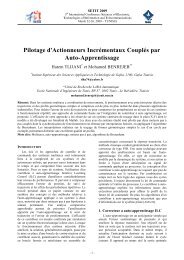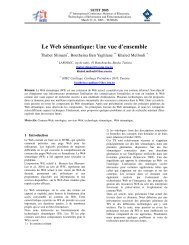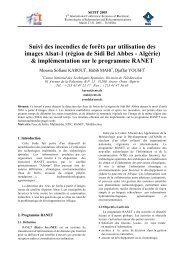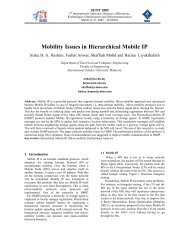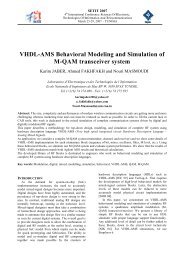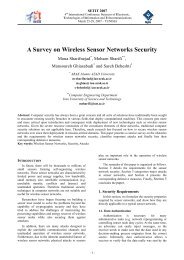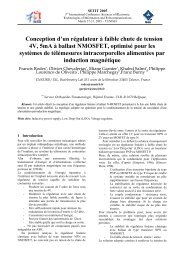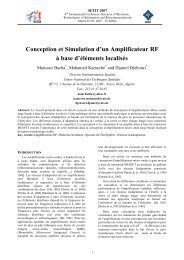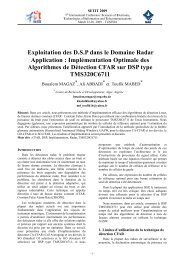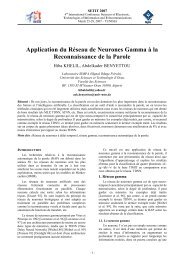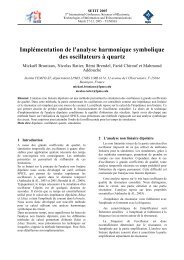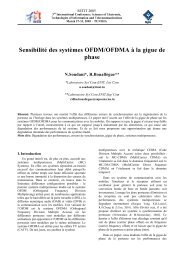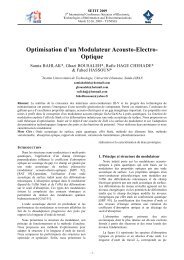Contribution of Multidimensional Trellis Coding in VDSL Systems
Contribution of Multidimensional Trellis Coding in VDSL Systems
Contribution of Multidimensional Trellis Coding in VDSL Systems
Create successful ePaper yourself
Turn your PDF publications into a flip-book with our unique Google optimized e-Paper software.
SETIT2005<br />
3.3 Simulation Results<br />
The <strong>VDSL</strong> system shall operate with a bit error<br />
ratio < 1 erroneous bit through 10 7 bits sent when<br />
operated over any loop with the noise models and<br />
simulation conditions specified <strong>in</strong> this section.<br />
Because <strong>of</strong> computer restrictions, we carried our<br />
simulations with a BER level equal to 10 -5 .<br />
Simulation defaults: We have simulated the 4D<br />
TCM method <strong>in</strong> the <strong>VDSL</strong> system described <strong>in</strong> Figure<br />
8 with three configurations <strong>of</strong> the truncation length K<br />
<strong>of</strong> the Viterbi decoder: K = 10, K = 125, and without<br />
truncation.<br />
The set <strong>of</strong> default parameters used <strong>in</strong> the<br />
simulations is listed below:<br />
• Number <strong>of</strong> Feed-Forward Equalizer (FFE)<br />
taps=32.<br />
• Roll-<strong>of</strong>f factor: α = 0. 2 .<br />
• Number <strong>of</strong> <strong>in</strong>formation bits per signal<strong>in</strong>g<br />
<strong>in</strong>terval=5.<br />
• Symbol rate: f baud = 2.16 MHz.<br />
• Carrier frequency: f c = 2.2275 MHz.<br />
• Sampl<strong>in</strong>g rate: f s = 4f baud = 8.64 MHz.<br />
• The sampl<strong>in</strong>g rate at the <strong>in</strong>put <strong>of</strong> the MMSE-FSE<br />
equalizer is L x f baud with L = 2.<br />
• Transmitted constellations = 32QAM for noncoded<br />
transmission, and 48QAM for trellis coded<br />
transmission.<br />
• The noise is additive, colored, and Gaussian<br />
ACGN. When whitened, its power spectral density<br />
(PSD) level is fixed to typically -140 dBm/Hz, which<br />
usually corresponds to the reference noise floor <strong>in</strong> the<br />
<strong>VDSL</strong> system.<br />
• As specified <strong>in</strong> the functional requirement<br />
documents (ETSI TS 101 270-1 v2.0.6 part1,<br />
2002)(ETSI TS 101 270-2 v2.0.3 part2, 2002), the<br />
PSD <strong>of</strong> the transmitted modulated signal is typically<br />
equal to -60 dBm/Hz.<br />
Simulation results: In tables 3 and 4, we show the<br />
cable range reaches and the channel capacity ga<strong>in</strong>s for<br />
the 4D TCM <strong>VDSL</strong> system.<br />
On one hand, Table 3 shows the difference <strong>in</strong> cable<br />
range reaches if we vary the truncation length K. For<br />
the values <strong>of</strong> K that exceed 125, the 4D TCM <strong>VDSL</strong><br />
cable range is typically constant. It is approximatively<br />
equal to 1270 m.<br />
On the other hand, the reach <strong>in</strong> the case <strong>of</strong> the<br />
32QAM non-coded <strong>VDSL</strong> system is typically equal to<br />
1180 m. In fact, the channel capacity associated for<br />
this value <strong>of</strong> the cable range is equal to 4.9823 bits.<br />
Beyond this value, the channel capacity becomes<br />
lower than the number <strong>of</strong> bits we want to send each<br />
signal<strong>in</strong>g <strong>in</strong>terval (b = 5). Thus, the 4D TCM <strong>VDSL</strong><br />
system gives a cable range ga<strong>in</strong> <strong>of</strong> 90m with the<br />
suitable value <strong>of</strong> K = 125.<br />
Table 4 shows the channel capacity ga<strong>in</strong> <strong>in</strong> terms<br />
<strong>of</strong> number <strong>of</strong> bits we can send through the channel for<br />
different values <strong>of</strong> cable ranges and K. We note that<br />
the use <strong>of</strong> the trellis Coded Modulation rather than the<br />
DQAM allows send<strong>in</strong>g 5 bits/signal<strong>in</strong>g <strong>in</strong>terval, even<br />
when the channel capacity (denoted bpsi <strong>in</strong> Table 4),<br />
calculated without tak<strong>in</strong>g <strong>in</strong>to account the ga<strong>in</strong><br />
<strong>in</strong>troduced by the TCM, is lower than 5. In our<br />
simulations, for K = 125 and BER = 10 -5 , the ga<strong>in</strong><br />
<strong>in</strong>troduced by the TCM <strong>in</strong>creases the channel capacity<br />
by 0.957 bits per signal<strong>in</strong>g <strong>in</strong>terval, which corresponds<br />
to 0.957 × 2.16 = 2.067 Mbps <strong>of</strong> rate ga<strong>in</strong>.<br />
Cable Length Erroneous Symbols BER<br />
K = 10<br />
1210 0 0<br />
1220 0 0<br />
1230 2 0.6e-5<br />
1240 6 e-5<br />
1250 6 1.2e-5<br />
1260 27 5.3e-5<br />
K = 125<br />
1260 0 0<br />
1270 0 0<br />
1280 5 1.2e-5<br />
1290 36 7e-5<br />
1300 39 9.7e-5<br />
Without Truncation<br />
1270 0 0<br />
1290 0 0<br />
1300 20 4.3e-5<br />
1400 247 5.22e-4<br />
Table 3. TCM SCM-<strong>VDSL</strong>: Cable range reaches for<br />
different values <strong>of</strong> the truncation length K<br />
K<br />
Cable<br />
Length<br />
Bpsi<br />
Ga<strong>in</strong><br />
10 1230 4.5822 0.4178<br />
125 1270 4.043 0.957<br />
No Trunc 1290 3.8172 1.1828<br />
Table 4. Channel capacity ga<strong>in</strong> for different values <strong>of</strong> K<br />
Conclusion<br />
The <strong>VDSL</strong> system is expected to be the solution to<br />
provide broadband services to residential and bus<strong>in</strong>ess<br />
on the exist<strong>in</strong>g copper plant.<br />
In this paper, we demonstrated that the <strong>Trellis</strong>-<br />
Coded Modulation with 4-dimensional rectangular<br />
constellations is superior to us<strong>in</strong>g 2D constellations.<br />
Us<strong>in</strong>g multi-dimensional rectangular constellations<br />
not only reduces the size <strong>of</strong> the constituent 2D<br />
constellations, but also improves the performance <strong>in</strong><br />
terms <strong>of</strong> both the cod<strong>in</strong>g ga<strong>in</strong> and cable range reaches.




